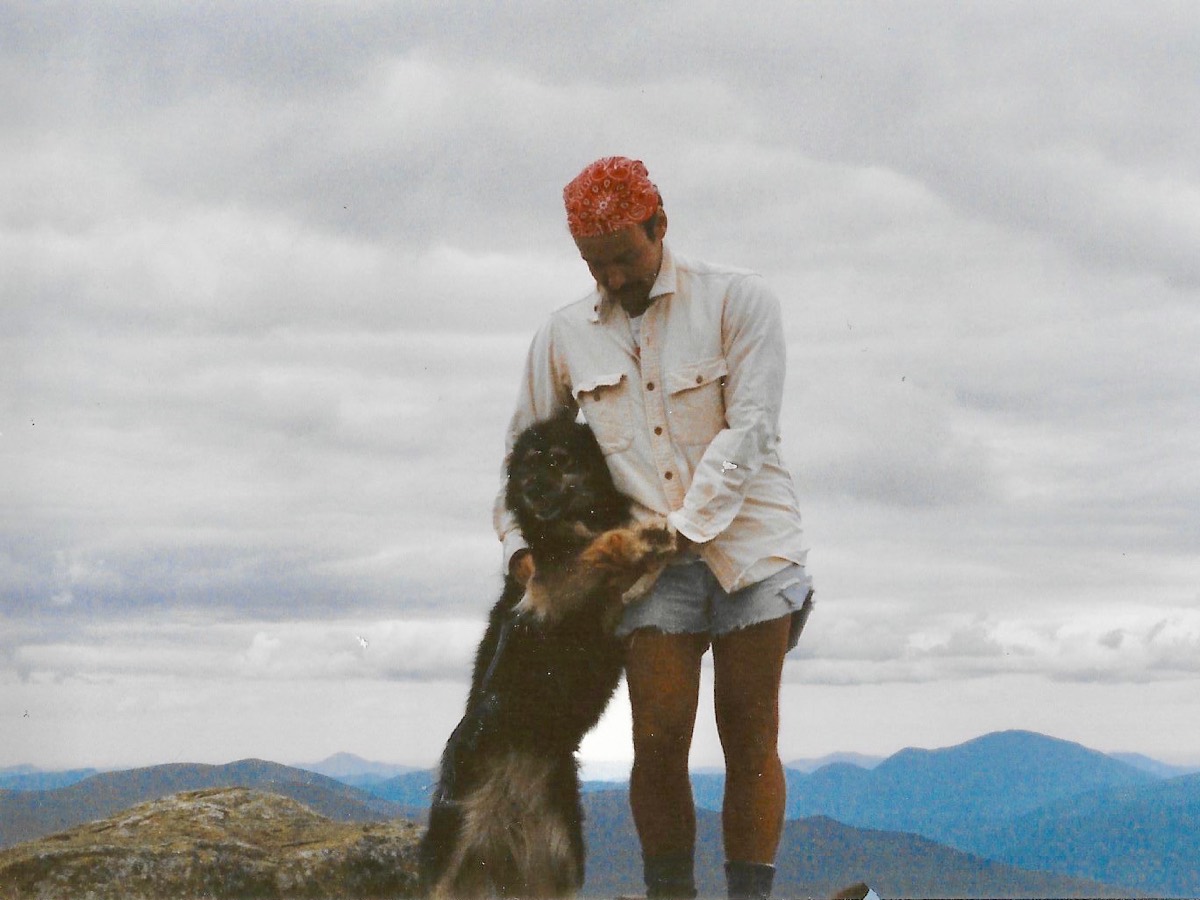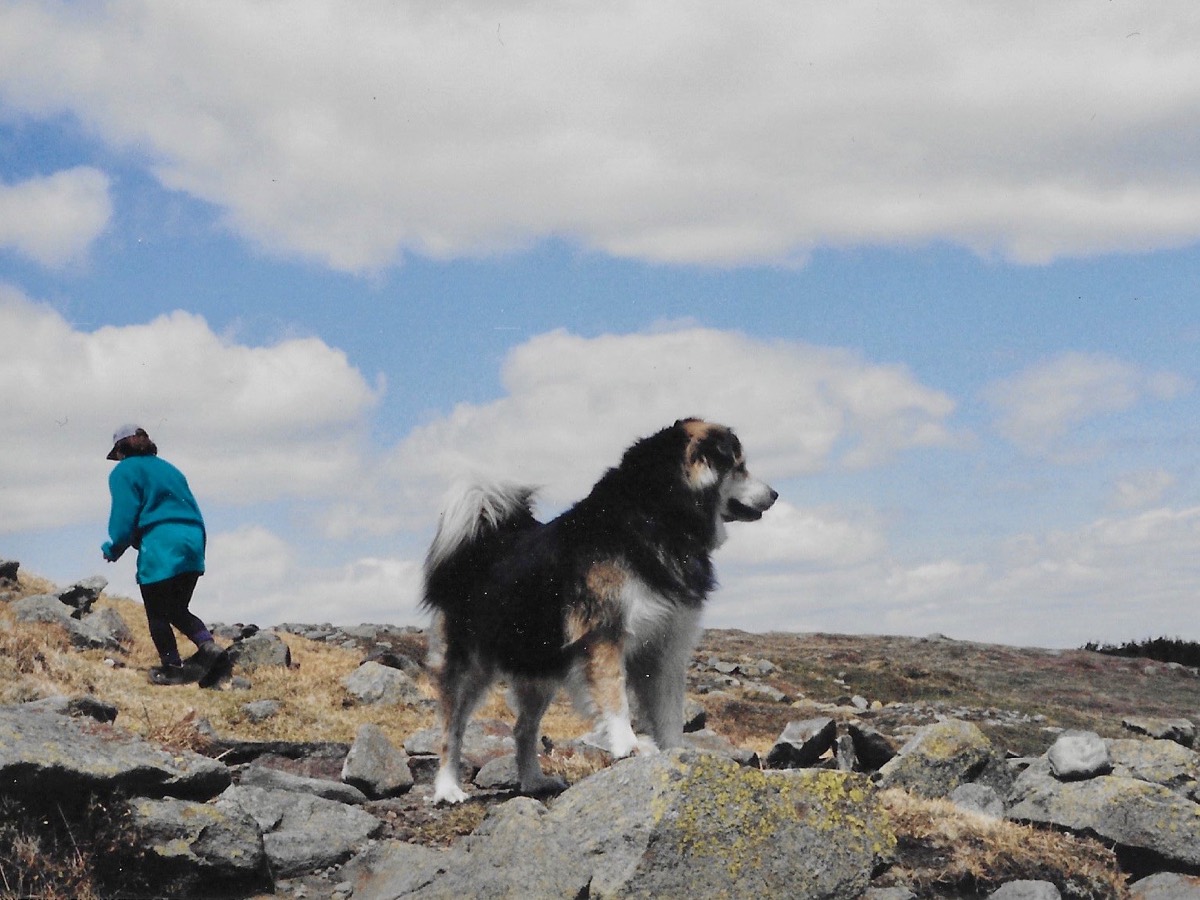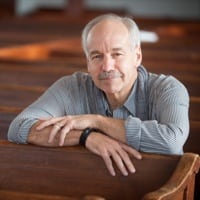Most of us seek our wild outside: we look beyond our daily walls; we nose into thickets; we watch for motion at the eye’s edge. And we climb into our mountains in search of what often seem to be the wild’s last reserves, those places where change comes at the slow hands of ice and light and not with the bass voice of explosives and the hurried snarl of a chainsaw. Once “away,” we await the meditative resonance that sometimes hums within us, the sense that we hear and feel Nature’s note.
But the long company of dogs has taught me to look also to another source for this spirit.
* * *
I am on a yellow school bus that’s navigating a narrow New Hampshire country road gone to dirt beside a rain-fat river coursing through the pinch of two ridges. The gray sky hangs just above the windows and words wash around me; everyone is talking. Chips of conversation float by: “That course was a bear;” “I’ve quit stretching;” “More rain.”
The straight-backed seat is hard, and even my 5′ 7″ frame is pretzelled in a knees-up position. The bus grinds forward in a lower gear, and I think, The start’s going to be downhill; keep yourself in check. Then, the bus lurches to a stop. Its brakes must, as they should, be excellent.
When we file from the bus, a wave of déjà vu sweeps over me–a familiar field rises toward a ridge of hardwoods, and there, a neatly-kept house with an el of barn parallels the raw road. I’ve been here before; when was I here? The question hangs with the mist. Then it resolves into the rain of memory.
* * *
Nearly 20 years ago in the late afternoon, I emerged from the woods below this ridge scratched and weary and with one dog only. Kelly, my brother’s dog, looked up expectantly; Sherlock, my dog, was still nowhere to be seen. A few hours and three miles of puckerbrush ago, Kelly and Sherlock had spooked a moose as the three of us ambled east along the Mowglis-Oregon ridgeline, and in the explosion of sound that followed, I listened as the commotion dopplered north down the slope. Yelps and breaking branches grew fainter; then a final bark and silence.
We’d covered the four trail-miles to our meeting with moose on a humid, summer afternoon that might or might not spawn thunder-rain, and now in the returned quiet, I waited. Five minutes later, Kelly slipped silently from the trees; I ruffled her fur and waited some more. No Sherlock. Five more minutes passed, and I stepped into the woods, found the moose’s tracks mixed with the dogs’, and began trailing them downhill; a half-mile later, in a stony brookbed, I lost them. For the next two hours, I fought my way down through the brush, calling Sherlock’s name every few minutes, waiting to hear the light footing of a returning dog. Calling again. Calling. Waiting. Nothing.
Sherlock had been “my dog” for all of three weeks, his recent rescue coming via my wife’s work as editor of our community newspaper. A street-dog picked up from nearby Lowell, Sherlock had done his 10 days at the local shelter without attracting an adopter, and so he’d been slated for being “put down.” But in those 10 days he’d attracted the heart of the staff, and so they’d decided to go public. Their appeal hadn’t even made the week’s paper; my wife had brought Sherlock home.
And those three weeks had already set a powerful bond in me; I was heartsick on this country road. I was also eight miles by trail and 25 miles by road from home with dusk coming on. After one more plaintive call into the woods, I knocked on the farmhouse door and asked to make the call that begins the aftermath of every loss. I needed a ride home, where I could make the next call and then set up the signage for the missing that never works.
* * *
There must be over a hundred of us milling around in the October morning mist. The Cockermouth River calls with last night’s rain, and a few eager or anxious sorts displace energy by jogging up and down the road. Lines stretch back from the two port-a-potties, and here and there, rogue males dart into the woods for relief. We are a remarkably mixed lot, I think, as I scan my foot-companions, seeing ages from early teens to a number who must be well north of my 63. If you were to walk a crowded city street and select 100 passersby to run a hilly half-marathon, you wouldn’t select this group; you might instead tend toward the lean and lupine, those who seem on the verge of breaking into escape strides even in everyday life. But here we are, a garrulous, well-fed crew that could have been plucked from cruising the tables of a farmer’s market for muffins and pie on this Saturday morning.
A race official calls us to a line scratched in the dirt; we shuffle into pack form, talking still. The 23-year-old who will win the race part of this run leans over the line; the few who will chase him do the same. His long hair hangs and curls, and his legs seem to descend flawlessly from his shorts. These minor Greek divinities seem to be at every race. Even standing still he is faster than everyone here.
My friends Rick and John and I shake hands. “See you in town,” we all say; each of us will run his own road.
“Okay,” says the official, “On your mark. Set. Go.” The beast stirs; its 200 feet scuff the dirt; it leaves for town.
* * *
Being in the woods with a young dog is an appreciation of motion: it is running through air rich with scents; it is following the nose’s narratives; it is yielding to instinct. Sherlock’s street-smarts seem also to translate into a question for me in the woods. Every dog chases squirrels. Few catch them. Sherlock rounds the bend in the trail with a squirrel, a quick red one even, draped perfectly from his mouth, its tail rich and glossy enough to have come from the fur stole my grandmother once wore. His eyes are alight with pride. I make a note to self: Now that I’m his food-winner, I need to figure a way to give Sherlock freedom of paw and to protect the animals that live along our trails.
* * *
I’m having a rare mature moment and starting this run slowly somewhere in the midsection of the shambling pack. At the same time a light rain begins; twinned with the 55-degree-Fahrenheit temps, it creates perfect running weather. Still, I’ve always been a sort of dog-runner, prone to the fits, starts, and meanderings of my native game soccer more than to the core, linear tracking resolve of a distance runner. Quick like a puppy to notice the peripheral, I’ve had to wait for time’s leash to slow me to the steadiness I’m hoping for today.
Some two miles along, the road becomes a cracked, rural tar that glistens faintly in the rain, and the pack is now stretched over a mile. From above we must look like a party-colored snake of some kind nosing along toward the lake. Everyone is finding his or her pace. A tall, younger man pulls silently up beside me. “Hey,” he says in modern greeting. “Hey,” I return and look at his soundless feet. He’s wearing Vibram FiveFingers, the “shoe” that gloves your feet so they look like, well, feet. “I like the sound you’re not making,” I say, and he smiles. I’m thinking he also must be glad to be off the stone-studded dirt. “How long have you been using them?” “About six months,” he says as we crest a rise; on the downhill, I pull away, and he pulls back beside me on the flat. “I can’t figure out the downhills yet, though.” Yes, the uncushioned heel-strike must be tough to avoid then, I think, and then as we go up again he pulls away. “See you in town,” he says.
While reading Born to Run a while ago, I too wondered what it would be like to run “naturally” over the long endurance races described in the book. Leave aside that the heat of the Tarahumara Indians’ Copper Canyon in Mexico would weigh on me like an anvil, I did find that landing on my midfoot returned me to a stride I’d used as a young athlete. And it kept me from overextending. But my “barefoot” experiments, even after watching YouTube clips of Barefoot Ted and the rest of the mixed and odd tribe, bruised me, and I returned to my shoes, ponying up a $100-plus every six months and occasionally sacrificing old t-shirts to the god of injury-avoidance.
The other moment that had stuck burrlike to my memory was the book’s theorizing about the origins of our distance-running abilities. When we run, theory posited, we return to our savannah selves, the long runners who tired game to exhaustion on the veldt of Africa; in this way of thinking we are not simply the big-brained, naked weakling animal of an evolutionary past, but rather also a formidable predator on two running feet. We are kin to the wolf, rather than a poor animal alternative. And now, given the easy prey of the supermarket aisles, the “game” we chase when we run instead is this wild elder-self, this integrated being receding still before us but visible by the small trail of dust rising from his feet.
Alone now on the glossy road and nearing the lake we’ll run beside for the middle miles, I find my mind drifting back to Sherlock. Wherever he’d come from his gene pool was deep in endurance–we’d always assigned his ears to husky ancestry–and unlike every other dog I knew, he could fall into a loping gait and keep it up for miles. When he wasn’t chasing down the world’s extended rodent family, or going on run-abouts that left me searching, he would run with me over trails, set up just behind my right heel. On those days I fancied myself a lead-dog, and it seemed I’d been given an extra animal-spirit. Surely, we were brothers.
My lead-dog reverie breaks when I look up and see the broad advertisement of t-shirt just in front of me. “Got Hill?” it asks in large blue letters, and yes, we do have hill. It bends up around a corner. Here in the run’s midsection, the road climbs over the end of a small chain of mountains that drop to the lake; we’ll crest that ridge and then descend a few hundred feet to the waterside road that squeezes beneath some cliffs. The water to our left will be over 500 feet deep, and in its darkness are stray cars and who knows what else. But now, I’ve got hill and I study the man bearing the shirt upward. I am, I decide, running behind a hobbit, though an exceedingly well muscled one. I am a head taller, and, I guess, given the strands of silver in his ponytail, younger! His calf muscles are formidable, however, and his footstrike soundless and steady–is there a hill they couldn’t climb? I decide to follow him up.
For over a mile, I trail Got Hill and then, along the downhill and flats, my longer stride eases me by. We will complete the run within minutes of each other, and as we talk, I will realize I have met the man I hope to be… at 73.
At some point in every run, it becomes, simply, work–the puppy mind is gone, energy stores dwindle, and you hope that the lead-dog within has the focus and the resolve to grind forward. Today, this stretch arrives around the nine-mile mark. At its aid station, I pick up some Gatorade and walk the few steps for drinking, and, when I go to resume my gait, I get protest–mild, yes, but evident. “Get in gear,” I say aloud to self. “Shorten strides, concentrate on keeping your footstrike forward; love the rain, love the terrain–this gentle uptick, for example: isn’t its slope perfect?”
Up ahead a white-haired head bobs to a walk. It’s my friend Rick, who mixes in a minute of walking for every 10 running; Rick runs some seconds faster than I do, but now I’m close enough to reach him during his slow minute. Seeing a friend creates a surge and it must summon that Gatorade I’ve just had as well–suddenly, the slope feels easy, and it launches me on the best miles of the day.
Seeing a friend is energy; passing a friend has a complicated little dynamic of excitement and regret–we are, after all, from the same pack. As I reach Rick, he begins running again, and a quick check says to me that he’s hit the same point I did a little while back–his head is down, he’s working hard on the upslope, his arms are flexed. His longer stride opens some yards between us, but only a few, and a few minutes later I slide by. “See you in town,” he says wearily. (Rick too will rally and find a finishing surge, pulling into town just after me.) The road opens before me.
* * *
That day 20 years ago, my brother’s wife drove around the mountain to retrieve me and their dog, Kelly. She said I had a welcome surprise waiting for me back at the house. There, asleep on the porch, was Sherlock. Apparently–he wasn’t talking–Sherlock had retraced our earlier steps, nosing along the four miles of ridge and valley he’d crossed only that morning to a home he’d known for the briefest time.
What attunes us to a place, places us in recognizable landscape? How, when we wander in various backcountries, do we know our way? We set up and follow trails, of course, and at their junctions we read the signs others have stuck there. But at some point, high along a ridge or deep in a thicket, we know the old region we’ve reached, and, given the right company–of spirit and paw–we remember who we are.
* * *
These miles along the lake’s populated south shore feel like running in the past, in many pasts. No, I’m not pacing along as I did in my thirties, but the soft, quick landings sound as if I’m padding along as some other me. And yet here I am fully me. I am working hard, and aware of it, but I also feel complete; I am my own running dog. And I will reach home.
[Author’s Note: A version of this essay first appeared in Senior Hiker, Issue 6, 2018.]
Call for Comments (from Meghan)
- If you have a dog that runs, have you watched it key into its natural surroundings?
- Have you ever seen a parallel between how you, your dog, or any animal interacts with the natural world?



